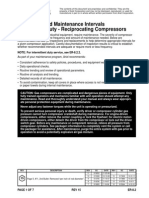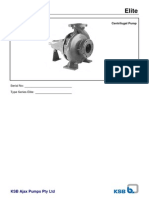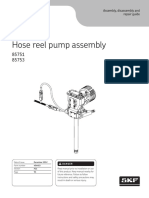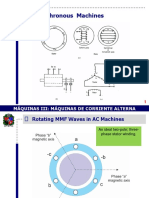VSE2020.V2: Cylinder Leakage Tester
VSE2020.V2: Cylinder Leakage Tester
Uploaded by
walson glen CrastaCopyright:
Available Formats
VSE2020.V2: Cylinder Leakage Tester
VSE2020.V2: Cylinder Leakage Tester
Uploaded by
walson glen CrastaOriginal Title
Copyright
Available Formats
Share this document
Did you find this document useful?
Is this content inappropriate?
Copyright:
Available Formats
VSE2020.V2: Cylinder Leakage Tester
VSE2020.V2: Cylinder Leakage Tester
Uploaded by
walson glen CrastaCopyright:
Available Formats
INSTRUCTIONS FOR:
CYLINDER LEAKAGE TESTER
MODEL NO: VSE2020.V2
Thank you for purchasing a Sealey product. Manufactured to a high standard this product will, if used according to these instructions and properly
maintained, give you years of trouble free performance.
IMPORTANT: PLEASE READ THESE INSTRUCTIONS CAREFULLY. NOTE THE SAFE OPERATIONAL REQUIREMENTS, WARNINGS AND
CAUTIONS. USE THIS PRODUCT CORRECTLY, AND WITH CARE FOR THE PURPOSE FOR WHICH IT IS INTENDED. FAILURE TO DO SO MAY
CAUSE DAMAGE AND/OR PERSONAL INJURY AND WILL INVALIDATE THE WARRANTY.
1. SAFETY INSTRUCTIONS 4. INSTRUCTIONS
Ensure that Health & Safety, local authority and general workshop OVERVIEW. Once the leakage tester has been connected to one of the
practice regulations are strictly adhered to when using tools. cylinders compressed air is fed into that particular cylinder through the
Maintain the equipment in good and clean condition for best and built in pressure regulator. Diagnosis is made by observing the amount
safest performance. DO NOT use if damaged. of leakage that is indicated on the cylinder leakage gauge and by
If required, ensure that the vehicle to be worked on is adequately listening for leakage at various points of the cars system.
supported with axle stands, ramps and chocks. 4.1 Location of listening points
WARNING! Select neutral (or ‘park’ if automatic transmission) 4.1.1 Oil Dipstick Tube - for leakage from damaged or worn rings
and keep hands clear of the engine as engine rotation may occur and/or cylinder wall.
when using this tool. The ignition MUST BE turned off. 4.1.2 Radiator FILLER - for cylinder wall cracks or head gasket leakage.
WARNING! Turn regulator knob fully anti-clockwise before 4.1.3 Adjacent Cylinder - for head gasket leakage.
connecting to compressed air. 4.1.4 Tail Pipe - for exhaust valve leakage.
Excess pressure will damage the gauge and will invalidate the 4.1.5 Carburettor Air Inlet - for inlet valve leakage.
warranty. 4.1.6 Fuel Injection Throttle Body - for inlet valve leakage.
Wear approved eye protection. A full range of personal safety 4.2 Connecting the system
equipment is available from your Sealey dealer. 4.2.1 Run the engine until it reaches operating temperature.
Wear suitable clothing to avoid snagging. Do not wear jewellery 4.2.2 Remove spark plugs, oil dipstick, radiator cap, air filter from
and tie back long hair. carburettor or, if fuel injected, remove air filter or hose from the
Account for all tools and parts being used and do not leave them throttle body.
in, on or near the engine. 4.2.3 Position No.1 piston at TDC on the compression stroke so that
IMPORTANT: Refer to the vehicle manufacturer’s service both inlet and exhaust valves are closed. Note: Always rotate the
instructions, or proprietary manual, to establish the current engine in the normal operating direction. To position the piston
procedure and data. These instructions are provided as a guide correctly use a piston position gauge and remove the cam/rocker
only. cover so that closed valves can be confirmed.
4.2.4 Screw the cylinder hose (see 'C' in parts diagram) into the spark
2. INTRODUCTION plug hole. If connecting to a 10 or 12mm thread, use adaptors 9
Designed to detect a variety of common engine faults including: or 10 as appropriate. Do not connect to the tester until the
Worn piston rings, worn valves, cracks in cylinder walls and leakage gauge (6) has been calibrated.
blown head gaskets. Available with either single gauge or twin 4.2.5 Screw a 1/4"BSPT male air line connector fitting into the
gauge manifold. Gauge(s) show % of cylinder leakage or cylinder threaded hole on the side of the regulator (connector not supplied).
leakage and cylinder pressure. Suitable for use on any petrol Turn the regulator knob on the tester fully anti-clockwise to shut
engine with 14, 12 or 10mm spark plugs. Supplied in carry-case down the regulator before connecting the air. Connect the
with instructions. compressed air, which must be between 45 and 100psi, to the
regulator.
3. Air Supply 4.2.6 Calibrate the leakage gauge by turning the regulator knob
clockwise until the needle on the right hand gauge reaches zero
The recommended hook-up is shown below. at the end of the yellow 'SET' band. (Typically, this will happen
3.1 Ensure that the air valve regulator is in the "off" position before between 15 to 20psi). Now insert connector 'A' on the cylinder
connecting to the air supply. hose into connector 'B' on the tester hose. Any leakage present
3.2 You will require an air pressure of 45 to 100psi. in the currently connected cylinder will show on the cylinder
WARNING! Ensure the air supply is clean and does not exceed leakage gauge as a percentage loss. A cylinder that is not
the pressure quoted. Too high an air pressure and/or unclean air leaking will read approximately 20% in the green band.
will shorten the life of the tester due to excessive wear and 4.2.7 Test all other cylinders, each at TDC, and compare the leakage
may be dangerous, causing damage and/or personal injury. figures to determine which cylinders are faulty.
3.3 Drain the compressor air tank daily. Water in the air line will 4.2.8 If necessary, retest the cylinder(s) showing high leakage. Check
damage the tester. the listening points (see 4.1) to determine the cause of the leakage.
3.4 Clean compressor air inlet filter weekly. 4.3 Helpful Suggestions.
3.5 Line pressure should be increased to compensate for unusually 4.3.1 If 100% or excessive leakage shows on gauge the cylinder may
long air hoses (over 8 metres). The minimum bore for hose and not be at TDC on the compression stroke. Check to ensure that
fittings is 1/4”. the valves are closed. Always try to position piston at TDC for
3.6 Keep hoses away from heat, oil and sharp edges. Check hoses uniform results.
for wear and make certain that all connections are secure. 4.3.2 If rings are broken or cylinder walls are scored excessive
leakage will be identified.
4.3.3 It is important that all cylinders have reasonably uniform readings
(as in compression testing). Differences in excess of 15%
indicate excessive leakage.
4.3.4 Large engines tend to leak more than small engines.
4.3.5 If leak is excessive on a vehicle with low mileage, piston rings
may be stuck. Treat engine with quality tune-up oil for a period of
time and then re-test before disassembling.
4.3.6 The lower the pitch of the leakage sound, the greater the leak.
4.3.7 To assist with listening use a length of clean hose, or a
mechanic’s stethoscope with the probe removed.
VSE2020.V2 ISSUE No:2 060809
4.3.8 When making repeat tests on the same cylinder, variations in the valves), the tester may indicate only the most serious fault.
piston position and engine temperature can cause gauge Note: There is always some leakage past the piston rings. As a result
readings to differ by up to 10%. you will always hear some leakage when listening to the dipstick tube.
4.3.9 If an engine has multiple faults (such as worn rings and burned
5. fault diagnosis
compression condition action/diagnosis
Low compression reading on some cylinders. (a) Use oil in cylinder to see if rings are worn.
(b) If compression increases, rings and/or cylinder wall are worn.
(c) If compression does not rise, do a cylinder leakage test to
determine source of problem.
High relative compression readings and relatively equal cylinder But, if excessive exhaust emissions, lack of power, poor performance,
readings. or poor fuel consumption do a cylinder leakage test to determine source
of problem.
Lower relative compression readings. One or more cylinders lower than Do a cylinder leakage test to determine source of problem.
others.
6. parts availability
ITEM PART NO: DESCRIPTION
2 VSE2020.V2-02 PRESSURE REGULATING VALVE
3 VSE2020.V2-03 VALVE
4 VSE2020.V2-04 HOSE
5 VSE2020.V2-05 PRESSURE GAUGE
6 VSE2020.V2-06 PRESSURE GAUGE
7 VSE2020.V2-07 CONNECTOR (FEMALE)
8 VSE2020.V2-08 HOSE WITH CONNECTOR
9 VSE2020.V2-09 CONNECTOR
10 VSE2020.V2-010 CONNECTOR
11 VSE2020.V2-011 O-RING
NOTE: It is our policy to continually improve products and as such we reserve the right to alter data, specifications and component parts without prior notice.
IMPORTANT: No liability is accepted for incorrect use of this product.
WARRANTY: Guarantee is 12 months from purchase date, proof of which will be required for any claim.
INFORMATION: For a copy of our catalogue and latest promotions call us on 01284 757525 and leave your full name, address and postcode.
Sole UK Distributor 01284 757500 www.sealey.co.uk
We b
Sealey Group,
Bury St. Edmunds, Suffolk. 01284 703534 email sales@sealey.co.uk
VSE2020.V2 ISSUE No:2 060809
You might also like
- 4110 Manual COMPLETO DENSOMETRO GURLEY PDFDocument21 pages4110 Manual COMPLETO DENSOMETRO GURLEY PDFZenón NoreñaNo ratings yet
- Operating & Maintenance Procedure For Air Cooler Heat ExchangerDocument10 pagesOperating & Maintenance Procedure For Air Cooler Heat Exchangerrahim_33516285678% (9)
- Operating Manual Parker Filtration UnitDocument27 pagesOperating Manual Parker Filtration Unitjjlameda9112100% (2)
- ARIEL Maint intervalSEK PDFDocument7 pagesARIEL Maint intervalSEK PDFMargaret Daugherty100% (1)
- Cylinder Leakage Tester 2 - Gauge Vse2020.V3: 1. SafetyDocument2 pagesCylinder Leakage Tester 2 - Gauge Vse2020.V3: 1. Safetyhotmaail4No ratings yet
- Pump-Elite - Operating InstructionsDocument12 pagesPump-Elite - Operating Instructionsbookslover1No ratings yet
- Diesel High Pressure Pump Test Kit: 1. SafetyDocument4 pagesDiesel High Pressure Pump Test Kit: 1. SafetyVladimirAgeevNo ratings yet
- Technical Note: 1.0 Maintenance ScheduleDocument6 pagesTechnical Note: 1.0 Maintenance ScheduleJhan Carlos RamosNo ratings yet
- 4475 PumpDocument10 pages4475 PumpchuckutoobuddyNo ratings yet
- Unit Ii Inspection of Piston EngineDocument45 pagesUnit Ii Inspection of Piston Engineraj6062No ratings yet
- Catalytic Converter and Exhaust Back PressureDocument2 pagesCatalytic Converter and Exhaust Back PressureeiochoaNo ratings yet
- SB 3-1-103Document19 pagesSB 3-1-103jussmeeeNo ratings yet
- 4110 Manual Completo Densometro GurleyDocument21 pages4110 Manual Completo Densometro GurleyZenón NoreñaNo ratings yet
- AIB - GVS - 20 Bomba de VacioDocument11 pagesAIB - GVS - 20 Bomba de VacioRico GonzalezNo ratings yet
- 3405P369 - Tool For Tightness TestDocument4 pages3405P369 - Tool For Tightness TestSylvek91No ratings yet
- Healthcare Pin Index Cylinder Instruction Guide LeafletDocument4 pagesHealthcare Pin Index Cylinder Instruction Guide LeafletAlemuNo ratings yet
- MODEL V305000000 PMV 5:1 Oil Pump Series "A": Form 404421 MAR - 2012 SectionDocument12 pagesMODEL V305000000 PMV 5:1 Oil Pump Series "A": Form 404421 MAR - 2012 SectionFaidh Maulana Aksyar FaidhNo ratings yet
- L V406000000 GogigggDocument12 pagesL V406000000 Gogigggilyaswinduaji014No ratings yet
- Braking System r1300Document23 pagesBraking System r1300Jarrod DebonoNo ratings yet
- VS200.V2 SealeyDocument2 pagesVS200.V2 SealeyaudioimagenNo ratings yet
- Proceso de Mantenimiento Maquina AnestesiaDocument20 pagesProceso de Mantenimiento Maquina AnestesiaSHIRLEY GIRALDONo ratings yet
- Service Instruction: LycomingDocument4 pagesService Instruction: LycomingGANo ratings yet
- Scania dc12 Cylinder Head TestDocument6 pagesScania dc12 Cylinder Head TestaliNo ratings yet
- Installation and Maintenance Information: Turbine Powered StartersDocument12 pagesInstallation and Maintenance Information: Turbine Powered StartersAbdelkader AbdelkaderNo ratings yet
- MODEL No: VS211.V2: Fuel Injector Test Device 12V - PetrolDocument3 pagesMODEL No: VS211.V2: Fuel Injector Test Device 12V - Petrolnicolae_popescu_18No ratings yet
- 4 Maintenace Inspection ProceduresDocument15 pages4 Maintenace Inspection Proceduresbudi utamaNo ratings yet
- Sis 631 PRTDocument15 pagesSis 631 PRTAshraf m aliNo ratings yet
- RK-753 ManualDocument20 pagesRK-753 ManualaataevNo ratings yet
- Valtek MK1 IOMDocument12 pagesValtek MK1 IOMJuan HernandezNo ratings yet
- Standard Gate Valves ManualDocument8 pagesStandard Gate Valves ManualmechanikyNo ratings yet
- Balcrank 1130-001 Tiger PumpDocument8 pagesBalcrank 1130-001 Tiger PumpJoseph GeraciNo ratings yet
- VS2050Document2 pagesVS2050ΜΠΑΜΠΗΣ ΛΙΑΤΟΣNo ratings yet
- Trainer GuideDocument16 pagesTrainer GuideCrystal DavisNo ratings yet
- Hsignode': 'T:ffiDocument22 pagesHsignode': 'T:ffiandiyuliusNo ratings yet
- Installation and Maintenance Information: StartersDocument32 pagesInstallation and Maintenance Information: StartersRicardoAguilarHidalgoNo ratings yet
- Calypso 2nd Stage Service ManualDocument20 pagesCalypso 2nd Stage Service ManualZohir Alouache100% (1)
- PT 102662 Iom UsDocument5 pagesPT 102662 Iom UsMo ZeroNo ratings yet
- Hose Reel Pump Assembly: Assembly, Disassembly and Repair GuideDocument18 pagesHose Reel Pump Assembly: Assembly, Disassembly and Repair GuideВиталий КозловскийNo ratings yet
- IM107Document36 pagesIM107Stefano Di LuccaNo ratings yet
- Heed 3 Tech Manual 2013Document4 pagesHeed 3 Tech Manual 2013mecambNo ratings yet
- CTV Svb62a en - 01232012Document3 pagesCTV Svb62a en - 01232012Homero PolancoNo ratings yet
- ZT 6000 VSDocument14 pagesZT 6000 VSdesign_artNo ratings yet
- Cocu 3 (Lite) Intro g452 JB1Document21 pagesCocu 3 (Lite) Intro g452 JB1sreetharanNo ratings yet
- Hct-3000 Tester InstructionsDocument4 pagesHct-3000 Tester InstructionssimonNo ratings yet
- Kysor On/Off Rear Air Fan Drive: Installation - ServiceDocument12 pagesKysor On/Off Rear Air Fan Drive: Installation - ServiceeloyabnerNo ratings yet
- Blower Systems TroubleshootingDocument4 pagesBlower Systems TroubleshootingRahul ChandrawarNo ratings yet
- Especificaciones Bomba Ventilador CATD10T - TestDocument36 pagesEspecificaciones Bomba Ventilador CATD10T - TestRafael RodriguezNo ratings yet
- Air Dryer CheckDocument4 pagesAir Dryer CheckCristhian Samuel Yacila OrdinolaNo ratings yet
- Holley Carb AdjustmentsDocument8 pagesHolley Carb AdjustmentsAaron SteeleNo ratings yet
- Bulletin 4002 O&M Manual For CL-16-26-56 Revised 10-15-2014Document15 pagesBulletin 4002 O&M Manual For CL-16-26-56 Revised 10-15-2014Docente 361 UMECITNo ratings yet
- BulletDocument68 pagesBulletjasonspectorNo ratings yet
- Separator (Grs-10eb 100eb) Manual (Rev3)Document16 pagesSeparator (Grs-10eb 100eb) Manual (Rev3)keniurgNo ratings yet
- Rotalube-Stewart Systems 4 Outlet PDU SystemDocument21 pagesRotalube-Stewart Systems 4 Outlet PDU SystemĐất RồngNo ratings yet
- Instruccion Manual Quincy QSTDocument36 pagesInstruccion Manual Quincy QSTJavier CevallosNo ratings yet
- Q&M GeneralDocument0 pagesQ&M GeneralPhu NguyenNo ratings yet
- Hematocrit-Manual Ifuge HCT NeuationDocument24 pagesHematocrit-Manual Ifuge HCT NeuationYanira RosasNo ratings yet
- 2.5HP 50 Litre Belt Drive Air Compressor: Instruction ManualDocument13 pages2.5HP 50 Litre Belt Drive Air Compressor: Instruction ManualmogsiNo ratings yet
- Installation and Operation Instructions For Custom Mark III CP Series Oil Fired UnitFrom EverandInstallation and Operation Instructions For Custom Mark III CP Series Oil Fired UnitNo ratings yet
- BBGJ1004Document100 pagesBBGJ1004walson glen CrastaNo ratings yet
- 03 LexusDocument7 pages03 Lexuswalson glen CrastaNo ratings yet
- Technical Information: Engine Cylinder Leak - Down TestingDocument2 pagesTechnical Information: Engine Cylinder Leak - Down Testingwalson glen CrastaNo ratings yet
- Battery DrainDocument12 pagesBattery Drainwalson glen CrastaNo ratings yet
- 30 امتحان قصير 1ث ترم اولDocument30 pages30 امتحان قصير 1ث ترم اولreroNo ratings yet
- Disaster Readiness & Risk Reduction: Grade 11-STEMDocument3 pagesDisaster Readiness & Risk Reduction: Grade 11-STEMNelson TapalesNo ratings yet
- Mung Bean IntroductionDocument1 pageMung Bean IntroductionDacks WangNo ratings yet
- I-Elite Iteracare BOP - EngDocument105 pagesI-Elite Iteracare BOP - EngJTS Maju Jaya Sdn Bhd100% (2)
- 1st Place Solution To Google Landmark Retrieval 2020 ModifiedDocument3 pages1st Place Solution To Google Landmark Retrieval 2020 ModifiedWisam NajiNo ratings yet
- APFC Relay Catalogue - 12 StepDocument5 pagesAPFC Relay Catalogue - 12 SteparunNo ratings yet
- Proceeding MGEI 2016 PDFDocument134 pagesProceeding MGEI 2016 PDFReza Fachruddin Zuhdi100% (1)
- Module 1: Introduction To Information and Communication TechnologyDocument4 pagesModule 1: Introduction To Information and Communication TechnologyJane Arcon del RosarioNo ratings yet
- Binormal - MathsDocument24 pagesBinormal - MathsselbalNo ratings yet
- (Chapter 3) Science, Technology, and Nation-Building: Colonial PeriodDocument3 pages(Chapter 3) Science, Technology, and Nation-Building: Colonial Periodjoy benedictoNo ratings yet
- (2024) Epigenetic-Circadian Clocks and PCOSDocument9 pages(2024) Epigenetic-Circadian Clocks and PCOSPetite PoubelleNo ratings yet
- Aps eDocument4 pagesAps elokalizator.maps1No ratings yet
- Sustainable Business Survey QuestionnaireDocument9 pagesSustainable Business Survey Questionnairedeniseflim100% (1)
- Sony Hvr-A1j, A1u, A1n, A1e, A1p, A1c Service Manual Ver 1.3 2007.03 (9-876-892-11)Document446 pagesSony Hvr-A1j, A1u, A1n, A1e, A1p, A1c Service Manual Ver 1.3 2007.03 (9-876-892-11)Susana MilhõesNo ratings yet
- Episode 414 - Electromagnetic Induction - 0Document52 pagesEpisode 414 - Electromagnetic Induction - 0Melchi VincoyNo ratings yet
- Result KSDDocument17 pagesResult KSDrakumar500No ratings yet
- Chronic Suppurative Otitis MediaDocument15 pagesChronic Suppurative Otitis MediaEza IndahsariNo ratings yet
- Kind Attn. Mr. Rohit Batnagar, Additional Gm-Purchase PH:9214337014Document7 pagesKind Attn. Mr. Rohit Batnagar, Additional Gm-Purchase PH:9214337014Corrosion FactoryNo ratings yet
- Chemistry Atomic-StructureDocument10 pagesChemistry Atomic-Structuremangeshchavan980No ratings yet
- Catalog 2U PSW 3KVA PDFDocument2 pagesCatalog 2U PSW 3KVA PDFYoughorta TIRNo ratings yet
- Sec 1 Math Shuqun Sec SA2 2017Document26 pagesSec 1 Math Shuqun Sec SA2 2017Nikita KhooNo ratings yet
- Synchronous Machines3Document103 pagesSynchronous Machines3Daniela Castro100% (1)
- Ascorbic Acid in Hot PepperDocument4 pagesAscorbic Acid in Hot PepperDonato CretiNo ratings yet
- Chapter 16Document6 pagesChapter 16Kaishe RamosNo ratings yet
- The Effects of Red Bull Energy Drink On Human Performance and MoodDocument12 pagesThe Effects of Red Bull Energy Drink On Human Performance and MoodwhochismoNo ratings yet
- Simple Ways To Test Dogs For Rabies - 9 Steps (With Pictures)Document5 pagesSimple Ways To Test Dogs For Rabies - 9 Steps (With Pictures)kaminiNo ratings yet
- Planegea Sample DNDDocument23 pagesPlanegea Sample DNDe.a.mestelloNo ratings yet
- Ids-2cd7a46g0p-Izhsy Datasheet v5.5.130 20200727Document8 pagesIds-2cd7a46g0p-Izhsy Datasheet v5.5.130 20200727Jose PeñaNo ratings yet
- 4th Quarter Week 9 Day 3Document13 pages4th Quarter Week 9 Day 3Lexter GaryNo ratings yet
- 03 x03 Activity Costs WPDocument18 pages03 x03 Activity Costs WPjesreygarnace4No ratings yet





























































































